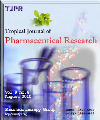
|
Tropical Journal of Pharmaceutical Research
Pharmacotherapy Group, Faculty of Pharmacy, University of Benin, Benin City, Nigeria
ISSN: 1596-5996
EISSN: 1596-5996
Vol. 8, No. 6, 2009, pp. 491-499
|
 Bioline Code: pr09063
Bioline Code: pr09063
Full paper language: English
Document type: Research Article
Document available free of charge
|
|
|
Tropical Journal of Pharmaceutical Research, Vol. 8, No. 6, 2009, pp. 491-499
| en |
Pharmaceutical Equivalence of Some Commercial Samples of Artesunate and Amodiaquine Tablets Sold in Southwestern Nigeria
Odunfa, O.O.; Adegoke, O.A. & Onaga, I.C.
Abstract
Purpose:
To study the physical properties and dissolution profiles of commercial samples of
artesunate and amodiaquine tablets.
Methods:
Fifteen generic brands of artesunate and five generic brands of amodiaquine tablets were
obtained from drug retail outlets in Oyo and Ogun States in southwestern Nigeria. The tablets were
subjected to various compendial tests including identification, weight uniformity, uniformity of content,
content of active ingredient and uniformity of diameter. Additional tests used as a basis for the
assessment of the pharmaceutical equivalence of the products include hardness, disintegration time and
dissolution rate. Data obtained were analysed by correlation analysis, Chi-square and ANOVA.
Results:
Thirteen generic brands of artesunate (87 %) and four amodiaquine brands (80 %)
investigated were imported. Two brands of the imported artesunate brands were found to contain
undetectable amount of artesunate while another 8 samples contained overages. All the amodiaquine
brands passed the assay test as stipulated by United States Pharmacopoeia (USP) for amodiaquine
tablets while tablet disintegration time of amodiaquine products ranged from 5.8 - 20.7 min. All but one
artesunate sample passed the disintegration test too. A majority of the artesunate brands tested had
significantly different dissolution profiles (p < 0.05). Four (80 %) of the amodiaquine tablet brands tested
had similar dissolution profiles and percent drug released within 30 min (p > 0.05). One amodiaquine
brand demonstrated poor dissolution profile as it did not meet minimum dissolution requirements within
30 min.
Conclusion:
The detection of substandard artesunate tablets and a poorly formulated amodiaquine
tablet amongst the few sample brands studied highlights the need for increased drug surveillance and
monitoring of the qualities of antimalarial medicines currently in use in order to prevent widespread
treatment failure.
Keywords
Artesunate tablets; Amodiaquine tablets; Tablet hardness; Disintegration time; Dissolution profile; Pharmaceutical equivalence; Drug surveillance and monitoring.
|
| |
© Copyright © Pharmacotherapy Group, Faculty of Pharmacy, University of Benin, Benin City, 300001 Nigeria.
Alternative site location: http://www.tjpr.org
|
|
